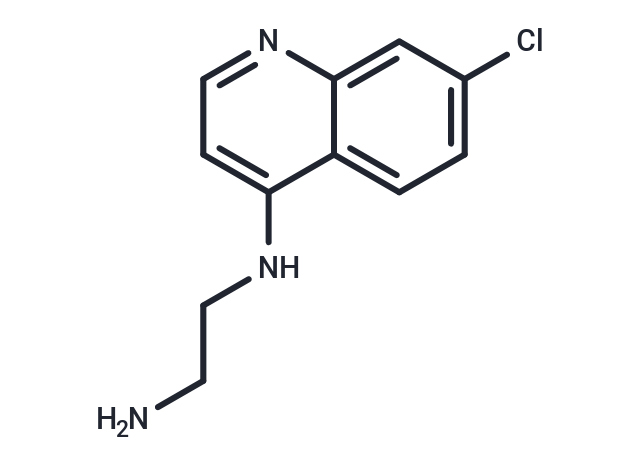
4-(2-Aminoethyl)amino-7-chloroquinoline
CAS No. 5407-57-8
4-(2-Aminoethyl)amino-7-chloroquinoline( —— )
Catalog No. M37048 CAS No. 5407-57-8
4-(2-Aminoethyl)amino-7-chloroquinoline (N1-(7-Chloroquinolin-4-yl)ethane-1,2-diamine) has potential anthelmintic and antitumor activity for the study of malaria.
Purity : >98% (HPLC)
 COA
COA
 Datasheet
Datasheet
 HNMR
HNMR
 HPLC
HPLC
 MSDS
MSDS
 Handing Instructions
Handing Instructions
| Size | Price / USD | Stock | Quantity |
| 50MG | 30 | In Stock |


|
| 100MG | 41 | In Stock |


|
| 500MG | Get Quote | In Stock |


|
| 1G | Get Quote | In Stock |


|
Biological Information
-
Product Name4-(2-Aminoethyl)amino-7-chloroquinoline
-
NoteResearch use only, not for human use.
-
Brief Description4-(2-Aminoethyl)amino-7-chloroquinoline (N1-(7-Chloroquinolin-4-yl)ethane-1,2-diamine) has potential anthelmintic and antitumor activity for the study of malaria.
-
Description4-(2-Aminoethyl)amino-7-chloroquinoline (N1-(7-Chloroquinolin-4-yl)ethane-1,2-diamine) has potential anthelmintic and antitumor activity for the study of malaria.
-
In Vitro——
-
In Vivo——
-
Synonyms——
-
PathwayMicrobiology/Virology
-
TargetParasite
-
RecptorParasite
-
Research Area——
-
Indication——
Chemical Information
-
CAS Number5407-57-8
-
Formula Weight221.69
-
Molecular FormulaC11H12ClN3
-
Purity>98% (HPLC)
-
Solubility——
-
SMILESNCCNc1ccnc2cc(Cl)ccc12
-
Chemical Name——
Shipping & Storage Information
-
Storage(-20℃)
-
ShippingWith Ice Pack
-
Stability≥ 2 years
Reference
molnova catalog



related products
-
Avermectin B1a
Avermectin B1a is a macrocyclic lactone disaccharide anthelmintic agent .
-
Piperaquine
Piperaquine is a bis-quinoline compound that inhibits the ex vivo growth of P. falciparum isolates from malaria-infected patients with IC50s ranging from 11.8-217.3 nM.
-
Doramectin
A derivative of ivermectin that approved for the treatment of parasites; a veterinary drug.



 Cart
Cart
 sales@molnova.com
sales@molnova.com


